In the Beginning
Those magnificent men on their rally machines
As a passionate curator of motorcycle rally history and its memorabilia, I am, as you may know by now, fascinated by everything about the first official motorcycle rallies. Hence my desire to share with you today, their brief history, with a journey through their commemorative badges and medals.
- Jean-Francois Helias
The early American rallies
Among my extensive photographic collection of commemorative rally souvenirs; (badges, medals, key holders, patches, diplomas, postcards, etc.), there are images proving that as early as the early 1910s there were enthusiasts in America already organising official meetings.
In the early years of American motorcycling, small groups of riders would gather and organise an overnight ride to a designated location or event, such as a race or an endurance ride. These events came to the attention of the public in general, and since long distance riders would often camp on the journeys to and from the event, the term 'Gypsy Tour' came to describe them.

CFA Motor Club 1911 - Members posing with their machines
In 1913, the Good Fellowship Tour was held in Milwaukee, Wisconsin. It originally started as a gathering of like-minded enthusiasts from all over the USA, converging on a single destination, to enjoy the camaraderie of motorcycling. In the event however, it proved enormously popular and ultimately formed the blueprint for other meetings across the country.
Three years later, in 1916, the first unofficial Gypsy Tour was organised in Laconia New Hampshire, attracting around 150 riders.
This was followed in 1917 by the Federation of American Motorcyclists (FAM) sanctioning its first official Gypsy Tour, but sadly the newly formed federation ceased to exist in 1919 due to declining membership. However, in 1925, the American Motorcyclist Association (AMA), which still exists today, became the official sponsor of the Gypsy Tours.
The rare medals of the first Gypsy Tour 1917 and the subsequent 1925 edition.
The early Italian rallies
In Europe, the very first official rallies took place in Italy around the same time.
My earliest image of the oldest medal commemorating an Italian 'raduno' (rally)shows it taking place on 25 May 1913 in Bolzano, in the South Tyrol province of north Italy; the second oldest in 1917, being in Trivero, in the Piedmont region.
The 1930s was an extremely rich period, with rallies right across Italy, as evidenced by the high volume of images in my collection, and in fact Italy's most legendary rallies to date emerged during that particularly fruitful time.
Two of the most prestigious were the winter rally, 'Rosa d´Inverno', whose first meeting took place on 12 January 1930; and the 'Raduno Moto Alpinistico del Pasubio', organised by AM Schio, dating back to 15 August 1934.
Medals of the initial Rosa d'Inverno rally in 1930, (left) and the Pasubio in 1934, (right)
These two rallies still exist today and enjoy a respected place in the world of Italian motorcycling.

Pasubio rally 1934 - Italian rallyists and their machines
Another renowned rally in the Italian motorcycling calendar, and still run today: the 'Madonnina dei Centauri', doesn't have its first meeting until a decade later. Indeed the first meeting, at Castellazzo Bormida didn't actually take place until after the war in the summer of 1946.
Commemorative medals of the Madonnina dei Centauri in 1947 (left) and 1950 (right)
The early German rallies
In the 1920s, long before the very first Elefantentreffen meeting in 1956, Germany was organising official rallies; most of them through auto-moto clubs affiliated to the Allgemeiner Deutscher Automobil-Club (ADAC). This was an automobile association founded on 24 May 1903, as German Motorbiker Association, and given its present name in 1911.
Commemorative medals of German motorcycle events from the 1920s
It's interesting to note at this point that from the 1920s, right up until the end of the 1960s, Germany is the leading European country for motorcycle organisations of all kinds: 'zielfahrt', 'sternfahrt', 'nachtfahrt', 'fuchsjagd', etc.

AWO Treffen 1960 - A view of the rally held in Kriebstein, in Saxony
The early Swiss rallies
In Switzerland, there are images of medals proving the existence of various organisations during the 1930s. However, these medals show the French word 'rally' with an 'e' at the end. The French word 'rallye' has a very different meaning to the English word 'rally'. It means a form of motorcycle sport that takes place on public or private roads in a point-to-point format, in which participants ride between set control points.
Badges of Swiss motorcycle 'rallyes' of the 1930s
We cannot therefore consider these organisations of the 1930s as meetings for rallyists in the proper sense of the term; but rather as sports competitions, even though it's obvious that some local bikers arrived by road to attend without participating as competitors.
The first authentic Swiss meetings took place in the early 1950s, starting with the first Swiss version of the Italian 'Madonnina dei Centauri', labelled 'Madone des Centaures', in 1952.
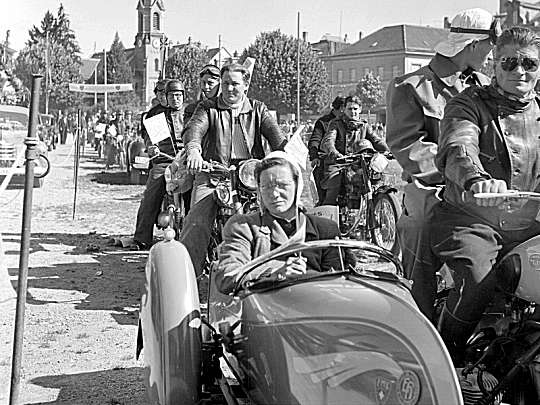
Madone des Centaures rally 1952 - The procession of rallyists in Fribourg
A second meeting of this rally, also held in Fribourg, followed on 26 June 1955; and a third one on 22 June 1958.
Badges of the 1955 and 1958 Madone des Centaures rallies in Fribourg
The early Austrian rallies
In Austria, in the 1930s, a few motorcycle organisations already existed and there were some motorcycle events with an element of competition such as Zielfahrt or Sternfahrt. However, most of the events of that period, as in Germany, were opened to both cars and motorcycles, and the first real motorcycle rallyists meetings only seem to have appeared much later in the 1950s.
Commemorative medals of ARBO rallies held in Gmunden, in 1965 (left) and 1966 (right)
The medals commemorating these meetings show that they were generally organised by ARBO. Founded in February 1916, ARBO is the second largest automobile association in Austria; OAMTC (Osterreichische Automobil Motorrad und Touring Club) being the largest.
The early French rallies
For France, the very first official rallies seem to have taken place at the end of the 1940s.
Pau rally 1949 - The MC du Bearn posing for a photo souvenir at the first rally
One of the best known at the time was the Pau rally who had their first meeting in 1949 organised by the Moto-Club du Bearn, who in turn were affiliated with the French Motorcycling Federation (FFM).

The 6th Pau rally 1954 commemorative diploma given to each participating club
In the 1950s French meetings were few in number as had been the case in the 1940s. The best known of the time being those held in Besancon: first meeting in 1951 and in Marseille in 1952.
Commemorative ashtray of the 1951 Besancon rally and badge of the second Marseille rally in 1953
France also had its French version of the Italian 'Madonnina dei Centauri', holding its first meeting in Lyon on 27 June 1954.
Badge and souvenir pennant of the first Madone des Centaures 1954 rally
The third 'Madone des Centaures' meeting took place on 17 June 1962 in Ambert, in Auvergne; the fourth on 13 June 1965, also in Ambert.

Madone des Centaures rally 1965 - The 'centaures' and their machines
The early Belgium rallies
From my archival evidence, it seems the very first rallies took place in the late 1940s.
Mons 1947 - Motorcyclists gathering in the capital of Hainaut province
It seems Belgium also had its own version of the Italian 'Madonnina dei Centauri' even before Switzerland and France.
The very first Belgium 'Madone des Centaures' was held in 1949 and organised then by the Auto Moto Club Le Roeulx, as shown below on the souvenir postcard given to each participant of the 5th meeting in 1966.

Commemorative postcard from the 5th Belgium 'Madone des Centaures' held on 4-5 June 1966
Of the few gatherings during the 1950s, the most popular seem to have been the Begonia rally in Gent, (first meeting in 1956); and the Aywaille rally.
Commemorative medals of the Aywaille rally 1958 (left) and the Begonia rally 1963 in Gent (right)
Belgium hosted many rallies from the mid-60s to the 80s for such a small country. The best known, in the world of 'die-hard' rallyists, remain to this day: Choucas (Marcinelles), Lion (Zolder), Hiberna (Marche en Famenne), Sangliers (Aywaille), Sinterklaastreffen (Oostende) and Steel Horse (Brugge).

Lion rally 1969 - Rallyists enjoying their lunch
The early Luxembourg rallies
Apart from the FIM rally organised in 1954 in the Duchy of Luxembourg, in collaboration with the Luxembourg Motor Union, it seems that the rallies held there started late 1960s.
It is quite possible that there were meetings organised prior to this period, but without any tangible evidence it is impossible to prove it.
Luxembourg rally 1969 - Rallyists at one of the very few rallies held in the 1960s
The 1970s however in this tiny country proved to be awash with meetings. Among the best known gatherings of this period: Brouch, Dudelange and Vallee de l'Our.
Commemorative badges of Dudelange 1974 (left) and Brouch 1974 (right)
The early Dutch rallies
The oldest photos of Dutch rally medals I have in my archive start in the late 1950s. Once again, it's entirely possible that some meetings took place well before this period, but I have no evidence to confirm this possibility.
Commemorative medals of the 2nd Molenrit 1958 (left) and of the Hondsrug Rallye 1968 (right)
Holland is also a country rich in motorcycle rally history. Among the best known in the 60s and 70s are: Amsteltreffen, Bambi Treffen, Eefde Bart Rit, Hondsrug-Rallye, Molentreffen, Paasei Treffen and Zeester Ontmoeting.

Mollen Treffen 1973 - my good friend Daniel Raphael (Rapha), member of the then MC Condate of Rennes, posing on his machine
The early Danish rallies
I don't have much documentation regarding the world of Scandinavian rallying and not being able to understand any of the four main Scandinavian languages doesn't help when trying to research information about them.
Finnish rallyists at an unknown gathering in the 1970s
As far as Denmark is concerned, the earliest documents I have date from the beginning of the 1970s. Unfortunately, I have no records prior to this, although it's likely that clubs organised rallies much earlier.
One of the most recognised rallies of the1970s was the 'Falke Traeffen'.
Badges of the Falke Traeffen 1972 (left) and 1975 (right)
The early Swedish rallies
Again, without records my best guess is that the first Swedish rallies appeared in the very late 60s.
One of the oldest to date and certainly the most popular seems to be the Hoglandstraffen organised by the Nassjo Motorcykelclub Smaland.

Hoglandstraffen 1971
The early Finnish rallies
I do however have documents proving there were rallies organised in Finland in the late 1960s, such as the famous 'Kontio Ralli' which still exists today

Kontio rally 1970 - Rallyists at the campsite
Other well-known old Finnish rallies of the 1970s include: Imatra, Katto, Kauha, Lalo and Saaristo.
Badges of the Imatra rally 1972 (left) and of the Kontio rally 1975 (right)
Early Norwegian rallies
Unfortunately, as with the other Scandinavian countries mentioned above, my documentation for Norway is similarly very limited.
What we know for sure is that a meeting took place as early as 1965 with the first Troll Rally, held in Grindaheim.
Badges of the Troll rally 1965 (left) and 1972 (right)
Speaking of the 1965 Troll rally, I'm delighted to share with you below this rare Scandinavian newspaper clip of the time. You might (like me) have trouble understanding the legend under the image, except perhaps for the more obvious part, saying 180 rallyists attended the meeting!

Besides the legendary Troll rally, the winter meeting of the Krystal rally, (first meeting in 1970) is also high on the list of the most famous Norwegian rallies.

1970s - Rallyists at an unknown rally in Norway
The early Spanish rallies
For Spain, research in my archive suggest that the first gathering there seemed to have been organised in 1976. This fits in chronologically with the freedom found at last by the Spanish people after the death of the dictator Franco in 1975.
Badges of the Ulldecona rally 1977 (left) and Barbastro rally 1977 (right)
The early Andorran rallies
The very first rally in the tiny principality of Andorra was held in October 1971. It was an immediate success with over 1000 rallyists booked a month in advance.

Andorra 1972 - participants at the 2nd meeting
For the record, the biggest prizes to be won by the participants at that first meeting were: a trip for 2 by plane to Casablanca, a Honda 750, a Honda 350 and a Honda 125. That rally saw its last meeting in 1977.
Badges of the Andorra rally 1971 (left) and 1972 (right)
The early Eastern European rallies
Numerous diverse events were organised from the 1930s in Eastern Europe: speed races, motocross races, ice races, regularity rallies, etc.
With the exception of the traditional FIM rallies organised in some of these Eastern European countries, (USSR in 1967; Poland in 1969 and 1975), there is no trace of local gatherings for rallyists prior to the 1960s. In fact, it seems that the very first rallies were apparently held in Poland in the late 60s by local Harley-Davidson owner clubs.
Badges of the 4th Wolsztyn rally 1973 (left) and the 7th Wroclaw rally 1976 (right)
The early British rallies
To give credit where credit's due, let's end this brief historic of early rallies with those from the United Kingdom!
Images of the oldest British medals and trophies in my archive, dating back as early as the 1910s, show the United Kingdom to have been extremely fertile ground for motorcycle events of all types: races, trials, hill climbs, runs, road rallies, etc.

British motorcyclists of the past gathering at an unknown event
To name just one among the most prestigious: the A.C.U National Road Rally which dates back to the 1930s.
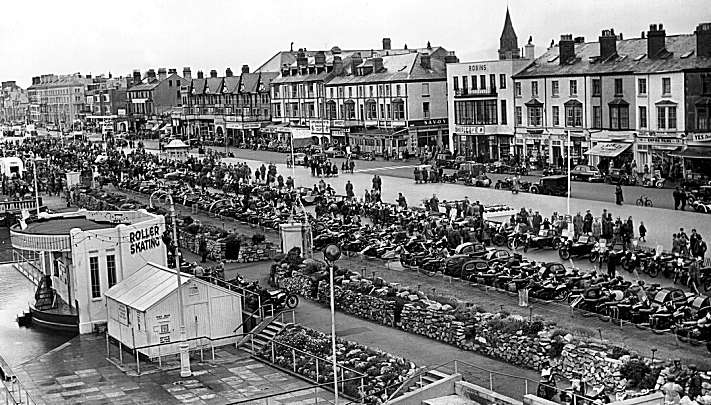
A.C.U National Road Rally 1954 - A superb view of the rallyists
It seems that the very first British gatherings were in fact organised in the mid-50s by a few individual owners clubs for their own members. For example: the annual rally of the Sunbeam OC or those of the Vincent OC.
The first Dragon rally in 1962 proved to be a watershed and is considered by many to be the origin of the British rally movement that ensued.
- Jean-Francois Helias
Dr Chris Potter mentioned motorcycle rallies in his thesis
"Motorcycle Clubs in Britain During the Interwar Period",
and the section is included here.
 After many years as a mature student, I was given the opportunity to do a doctorate on my lifetime's passion, motorcycling, which I completed at Northumbria University in 2007.
After many years as a mature student, I was given the opportunity to do a doctorate on my lifetime's passion, motorcycling, which I completed at Northumbria University in 2007.
The subject of my thesis was social and cultural aspects of motorcycling during the inter‑war period circa 1919‑1939.
Aspects of this included, gender, class, literature and the arts, the law, and clubs.

Motorcycle rallies were a way that clubs could mix with other clubs, or develop a social bond within their ranks, on a less competitive basis than at more serious sporting events.
They were usually run along the lines of a camping weekend, sometimes at or near some venue of interest. The data for 1932 shows that there were 11 clubs holding rallies, and an additional 5 holding what they described as camping weekends.
The Motor Cycle described the London Rally of Motorists, promoted by the North London MCC in 1925. It was held in Alexandra Park, and large Bank Holiday crowds enjoyed such spectacles as plank-riding, balloon-bursting, slow racing, apple-bobbing, tent-pegging, steeplechasing, musical chairs and bun-biting. In addition, awards were given for best-kept machines, and "most suitably attired lady rider", and there were also awards for numbers in other clubs attending.
Events such as this combined the desire of the rider to use his or her machine to the fullest extent, and indulge in what was considered to be an ideal way of getting back to nature, camping. It is this harmonization, which is interesting as it contrasts with the modernist nature of the machine. In attending rallies and camping weekends, the clubman or woman is attempting to return to nature by, to some extent, shaking off the trappings of industrialised society, whilst at the same time paradoxically using and enjoying one of its greatest achievements. The need to return to nature was a reaction to industrialisation and this reaction enjoyed a particular boom between the wars, although it held its origins prior to 1914, when the "rediscovery of the countryside" was well underway, with hiking and rambling becoming increasing popular.
Attending a motorcycle rally demonstrates "Modern hedonism," expressing individuals' need to indulge in the possibility of being the controller of their own destiny. The rallyist exercises control over the stimuli he or she experiences, and the pleasure received. By total emersion in their hobby, to the extent that they leave the confines of their homes, and do their best to make motorcycling, "their home" at least for a weekend, rallyists are indulging in a highly rationalized form of self-illusory hedonism which characterises modern pleasure-seeking. Motorcycle clubs were an ideal means for those of a gregarious nature to expand their horizons during a period when leisure time increased.
- Dr Chris Potter
Dave Richmond added a British perspective gained while researching for his excellent Motorcycle Timeline website.
The first rally was held in Richmond, Yorks in 1907. It was described as "the largest meeting of motor cyclists to date", with contingents from clubs in Newcastle (30), Sunderland (25), Hartlepool (25), Middlesborough (25), Leeds (30) and Bradford (16).

Here's the earliest rally report I've found so far, with club turnout, long distance and other awards...
ALTHOUGH SOMEWHAT MARRED BY stormy weather, the first annual inter-club rally of the North London MCC, held at Hendon on Saturday, was a decided success. The chief award, the challenge shield presented by Mr AJF Beaurain, was gained by the Connaught MCC, which attained the highest figure of merit (ie, percentage of members present multiplied by mileage from club headquarters).
A strong wind, unfortunately, nullified the facilities offered to those present for flights at a reduced rate, and although several flights were enjoyed, chief interest centred on the minor competitions. Mrs Uhde, of the Surbiton &DMCC, gained the special prize (a Vici carburetter) for having ridden the greatest distance to the meet, whilst Walter Scott's expenditure of energy in polishing his machine was rewarded by the gift of an Elite motor cycle cover. Both of these prizes were presented by the manufacturers.
Two 'gymkhana' events had for their awards copies of Motor Cycles and How to Manage Them and Tracing Troubles (presented by this journal) but on consideration it would seem that the former prize was almost too cruelly appropriate! EW Cholcroft's AJS sidecar won the prize of a Service motor cycle watch for having the most ingenious 'gadget'. His machine was fitted with several detail modifications, particularly to the lubricating system, and to the air intake of the carburetter.
There is little doubt that this rally will become a most popular annual event.
The Motor Cycle 1921

A Sunbeam sidecar driver successfully 'ringing' one of the posts in the 'Houp-la' competition at the North London MCC's Rally at Hendon last Saturday.
General view of some of the machines at the North London MCC's Rally, parked in Hendon aerodrome.
Still plugging away on my timeline of motor cycling I just came across this view of rallies in The Motor Cycle dated 1 March 1923. The Richmond meet they refer to (no relation) dated back to before the Great War and attracted hundreds of riders. So us soft southerners have to accept that rallies were invented up North...
MOTOR CYCLE MEETS AND RALLIES: Those blessed with youth and the keenness of youth are apt to be a little impatient of that type of club function which falls principally under the control of the social secretary - annual dinners and other strenuous indoor entertainments always excepted. The energetic club man who rides solo is seldom satisfied with any club fixture which does not fall into the speed contest, or reliability trial class.
For the older members who have taken to three wheels, or even four, either from considerations of safety or companionship, social events have their charms. As an opening run for the year's programme, for instance, a rally of the members at some beauty spot is an admirable event. It enables new models to be paraded and discussed; it gives new members a chance of becoming known and old members an opportunity of renewing acquaintanceships.
If such a rally can be undertaken collectively by a number of clubs in one area, the social value of the meeting is greatly enhanced. Perhaps the younger element will feel a certain aimlessness in gathering together at a particular place without a set programme, but a competitive atmosphere or an impromptu hill-climb may easily be incorporated.
At the Richmond meet in Yorkshire, it was the custom to give prizes to individual riders for such things as the best-kept machine over a certain age, the smartest. turn-out, the most ingenious item of home-made equipment, etc, in addition to a club prize for the largest percentage membership present, taking mileage into account. The main thing at such a meet is the necessity of having a definite though simple programme, which must be carried out strictly to schedule. Slipshodness in this respect is fatal.
The Motor Cycle 1923
Looking forward to seeing some old mates on a site again, post-lockdown.
- Dave Richmond
Francois found evidence of an American rally in 1924. You can buy a copy of this five-foot long photo from Etsy.
Western Federation of Motorcyclists Rally 1924, Pismo Beach, California. Hover your pointer over the photo to stop it panning.
The Western Federation of Motorcyclists was formed in 1912 by Harry Hodges, president of San Francisco MC. How come we don't have photos like this from rallies these days?
Don't worry, the pier isn't broken, it's the way the photos were stitched. In fact, it still ap-piers to be there a hundred years later, according to Google Street View.











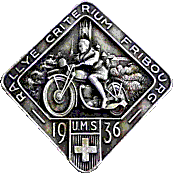
















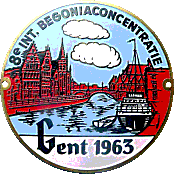




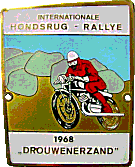





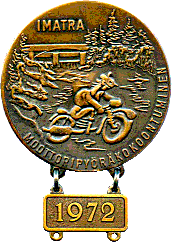
















 After many years as a mature student, I was given the opportunity to do a doctorate on my lifetime's passion, motorcycling, which I completed at Northumbria University in 2007.
After many years as a mature student, I was given the opportunity to do a doctorate on my lifetime's passion, motorcycling, which I completed at Northumbria University in 2007.


